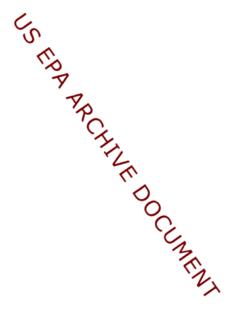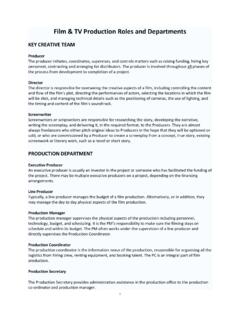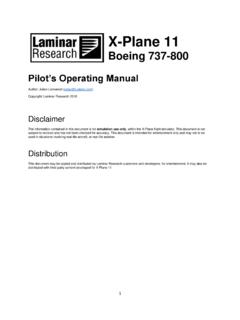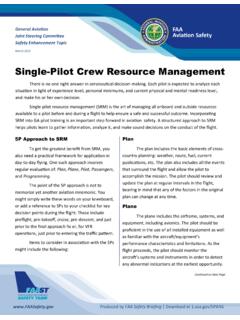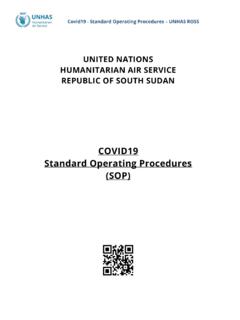Transcription of Standard Operating Procedures: Fire Hydrants
1 Standard Operating Procedures: Fire Hydrants Tammany Utilities TU Staff Fire Hydrant Management Goals The inspection, testing and maintenance of Tammany Utilities (TU) fire Hydrants is critical to determining the readiness of the Hydrants to provide water at fire emergencies. The inspections shall verify the location, accessibility, proper mechanical operation, and water flow from the hydrant. Annual Inspection Annual inspection by TU personnel of each hydrant to be completed during annual flow testing. Inspection (using TU hydrant inspection form) results to denote: Hydrant location Physical damage and defects to hydrant Obstruction on and around the hydrant Condition of the paint Minimum 18 inch clearance between the lowest outlet and ground level Road marker present Is it present?
2 Include/match against list of hydrant deficiencies provided by Fire District(s) Public vs. private hydrant Inspection Procedure: 1. Inspect the fire hydrant for accessibility. The center of the 4 -inch connection should be no lower than 18-inches above the ground. There should be no obstructions, including the ground, preventing easy coupling of hoses or turning of spanners. The hydrant should be visible from all approaches. There should be no brush or tree limbs that could interfere with anyone approaching the hydrant and attempting to connect to it or operate it.
3 2. Crews should make minor corrections such as pruning and minor digging. More significant work such as heavy brush removal, significant digging, placing of retaining walls to prevent hillside soil slough off, or the raising of bodies which are set too low, should be referred for correction by submitting a repair work order. 3. Trim bushes away from hydrant to maintain at least a 3-foot clear space. Inform the customer prior to removing any landscaping. Allow customer an opportunity to remove impediments to fire protection personnel and Tammany Utilities maintenance.
4 4. Remove dirt from hydrant s base. 5. Expose shut-off valve box. 6. Remove all caps and inspect threads and outlets for damage or obstruction. Replace caps with hydrant wrench slightly tighter than hand tight. 7. Open hydrant completely with caps in place. Determine water has filled hydrant and turn hydrant off completely. Note any difficulty opening hydrant. 8. Observe hydrant for proper draining. 9. Document inspection by indicating location, and any deficiencies noted, and date inspected. 10. Submit inspection report: a. Completed inspection forms shall be submitted and then distributed as follows: i.
5 TU West: Water crew Chief>Admin Asst>FD/Utility Manager ii. TU East: Field Supervisor>Admin Asst>FD/Utility Manager Condition Corrective Action Inaccessible Make accessible Barrel contains water Repair and drain; for high (presence of water or ice could indicate a faulty drain, a leaky hydrant valve, or high groundwater table) Improper drainage from barrel Repair drain Leaks in outlets or at top of hydrant Repair or replace gaskets, packing, or parts as necessary Cracks in hydrant barrel Repair or replace Tightness of outlets Lubricate if necessary; tighten if necessary.
6 Worn nozzle threads Repair or replace Worn hydrant Operating nut Repair or replace Reporting and Repair Procedures Reporting of hydrant condition and associated repairs comes from two sources, annual inspections and field reports from staff, customers and Fire District personnel. Inspections If a deficiency is found review of said deficiency issue by Compliance Officer/Water crew Chief/Field Supervisor and corrective action determined: Procure any needed appurtenances or new hydrant Work order for in-house repair Task Order for construction/maintenance vendor repair Field Reports If a deficiency is found review of said deficiency issue by Compliance Officer/Water crew Chief/Field Supervisor and corrective action determined.
7 Procure any needed appurtenances or new hydrant Work order for in-house repair Task Order for construction/maintenance vendor repair Fire Hydrant leak/damage/height report from TU staff/customer/Fire District staff If detected by field personnel, personnel to immediately call in work order Compliance officer/Water crew Chief/Field Supervisor notified TU East/West Admin Asst to work order and disseminate vial email Condition change noted on master hydrant list Fire District notification(s) Field response (short term): black bag? Quarterly review of open work orders for Hydrants by Field Supervisor and Utility Manager Flow Testing Fire flow tests are conducted to determine pressure and flow-producing capabilities at any location within the distribution system.
8 The primary function of fire flow tests is to determine how much water is available for fighting fires, but the tests also serve as a means of determining the general condition of the distribution system. Tammany Utilities flow testing will follow an annual schedule (schedule located in Resources section). Staff from the appropriate Fire District shall be invited to attend flow testing operations in order to garner the necessary information for said District s Property Insurance of Louisiana (PIAL) rating submission. Tammany Utilities personnel will also complete flow testing on an as-needed basis to determine condition of a particular water distribution system.
9




